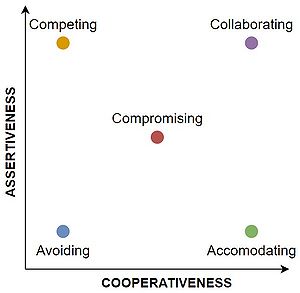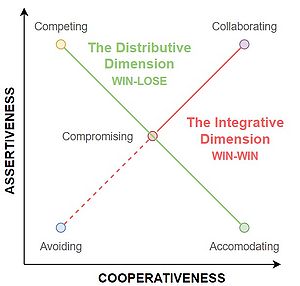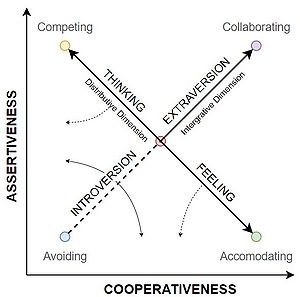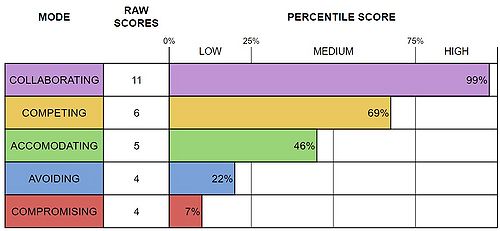Conflict Management using the Thomas-Kilmann Conflict Mode Instrument (TKI)
Developed by Stine Pagaard Haahr
Conflicts are common when working with other people on projects, programs, and portfolios. They should not necessarily be avoided since they can provide great value to team members and improve the final product. However, it is of great importance that team members and not least the project manager know how to manage the conflicts appropriately to avoid conflicts escalating and becomes inconvenient to the work [1]
This article will introduce the Thomas-Kilmann conflict mode instrument (TKI), developed by Kenneth W. Thomas and Ralf H. Kilmann. The purpose of the tool is to identify a person’s most used conflict handling modes and learn to manage conflicts [2].
The article will also introduce the correlation between the Myers-Briggs Type Indicator (MBTI) assessment and the TKI assessments, meaning that certain personality types tend to use certain conflict handling modes more frequent [3].
Contents |
Big Idea
Conflicts in project management
When working with projects, several competencies are relevant for the project managers to have. Technical competencies, to be able to direct, manage, plan, and deliver a project [4]. Business competencies, to be able to manage organizational, contractual, and external environment. And finally behavioral competencies, associated with leadership, team building, negotiation, and conflict management. Conflicts are defined as follows:
- " An interactive process manifested in incompatibility, disagreement or dissonance within or between social entities " – Rahim, 2010, p.16 [5].
This article targets the people perspective of projects (one of the four project perspectives; purpose, people, complexity, and uncertainty)[5]. A lot of people are involved in projects which make a dynamic environment, and the projects are often challenged with budget, scope, schedule, and quality [1]. These factors make conflicts common on projects – and almost inevitable. Trying to avoid conflicts is not necessarily the best solution, since it can restrict the communication between the parties involved and lower creativity. When addressing conflicts appropriately, they can be healthy and lead to a more productive process, better decision-making, and stronger solutions. The trust among project team members can also increase and cause a deeper commitment to the project. However, if conflicts are addressed inappropriately, they are unhealthy, can escalate, and can affect the project team members with reduced morale, motivation, and trust.
The TKI assessment

The Thomas-Kilmann Conflict mode instrument (TKI) is developed by Kenneth W. Thomas and Ralf H. Kilmann. Based on the Kilmanns 'Celebrating 40 Years with the TKI Assessment - A Summary of My Favorite Insights' [2], and Thomas and Kilmanns 'Thomas-Kilmann Conflict Mode Instrument - Profile and Interpretive Report' [6] and 'International Technical Brief for the Thomas-Kilmann Conflict Mode Instrument' [7] an introduction to the assessment tool will be given.
The TKI is a personality assessment, which examines an individual’s behavior when dealing with a conflict. The assessment identifies the relative frequency an individual tends to use each of the five different conflict-handling modes – competing, collaborating, compromising, avoiding, and accommodating. The purpose of the assessment is to become aware of the conflict handling modes an individual tends to use – consciously or unconsciously – and to learn how to purposely choose and use the right conflict handling mode for different conflict situations. An individual’s conflict behavior – and thereby the five conflict handling modes - can be categorized along two basic dimensions - assertiveness and cooperativeness. Assertiveness refers to an individual’s attempt to satisfy his or her own needs. Cooperativeness refers to an individual’s attempt to satisfy others’ needs. Each of the five conflict handling modes can be placed along the two dimensions.
Competing is high on assertiveness and low on cooperativeness. This means, that an individual tries to satisfy his or her own concerns at the other person’s expense.
Collaborating is high on both assertiveness and cooperativeness. This means that an individual tries to fully satisfy both his or her own concerns and the other person’s concerns.
Compromising is intermediate on both assertiveness and cooperativeness. This means, that an individual tries to partly satisfy both his or her own concerns and the other person’s concerns.
Avoiding is low on both assertiveness and cooperativeness. This means, that no one’s concern is attempted to be satisfied, but the conflict is avoided.
Accommodating is low on assertiveness and high on cooperativeness. This means, that an individual tries to satisfy the other person’s concerns at his or her own expense.

There are two diagonals within the TKI Conflict Model: the integrative dimension and the distributive dimension. The collaborating mode falls on the integrative dimension in the upper right corner and is considered a win-win situation. Although this conflict mode can occur as the most ideal, it is also the mode that depends on most conditions to be able to succeed. To be able to fully meet both parties’ concerns requires a lot of time and no stress. Mutual respect and honor, productive dialogue, and interpersonal skills are vital since this conflict mode requires each part to share innermost feelings and actively listen. Only then the underlying concerns can be shared and potentially met. Hence, this conflict mode is not always ideal to use.
The competing, accommodating, and compromising mode is placed along the distributive dimension. The nature of this dimension is the win-lose mentality. The more on parts concerns are met, the less the other parts' concerns are met and vice versa. It can be said that the size of the pie is fixed and must be distributed between the parties in contrast to the integrative dimension, where the size of the pie is available for both parties.
The TKI assessment and the MBTI assessment

A study from 1975 by Kilmann and Thomas [3] showed a correlation between the Myers-Briggs Type Indicator (MBTI) and the TKI assessment. The MBTI assessment identifies an individual’s personality type by evaluating the four dimensions
- Extroversion (E) vs introversion (I)
- Sensing (S) vs. Intuition (N)
- Thinking (TI) vs. Feeling (F)
- Judging (J) vs. Perceiving (P)
Correlations were found within two of the dimensions: extroversion vs. introversion and thinking vs. feeling[3]. It is important to state, that it is not a one-to-one correlation, but a statistically significant correlation. The two other dimensions, however, did not show a significant correlation. For more information on the study, read Interpersonal conflict-handling behavior as reflections of Jungian personality dimensions[3].
People high on extroversion tend to use the collaboration mode more during conflicts, whereas people high on introversion tend to use the avoiding mode more. As collaboration requires a lot of time and willingness to share ideas, feelings and discuss concerns, an individual must invest extra energy in interacting with the other part, which seems natural for the Extrovert individual. Individuals higher on Introversion on the other hand can seem more shy and more willing to withdraw from a conflict, which seems natural for the avoiding conflict mode.
In addition, the study also showed, that the Thinking individual tends to use the competing mode more during conflicts. This may be due to their ability to keep an emotional distance and accepting, that their own needs may be at expense of others. Finally, people high on feeling is correlated to the accommodating mode. This may be due to the Feeling person’s ability to be compassionate, consider other people’s feelings, have empathy, and be less willing to compete.
Application
How to take the TKI assessment

The TKI assessment is a questionnaire with thirty items, which the individual must respond to [7]. Based on the results, the items are scored and given as raw scores and percentile scores in the TKI profile. The raw scores are simply the number of times an individual chose that specific conflict handling mode in the TKI statements. However, the percentile score is based on a comparison with a representative sample of 8000 employed adults [6], who have also taken the TKI assessment. The percentile score indicates the percentage of people from the representative sample, who scored the same or lower than you.
From the example in Figure 4, it can be seen, that individual x had a raw score of 6 within the competing mode, which corresponds to a percentile score of 69%. This means, that the individual scored higher than 69 percent of the people in the competing mode.
The TKI profile also highlights the 25th and 75th percentiles as well as the middle 50 percent. Scores within the top 25 percent are considered the conflict handling modes, which are used most often. The bottom 25 percent are considered the ones which are used the least. The scores, which lie within the middle 50 percent are considered medium. If having such a TKI profile, that person should consider, if he or she uses the collaborating mode too often, and when it is not suited. On the other hand, he or she should consider, is avoiding and compromising is used too little, although it can actually be beneficial.
Implementation of TKI in conflict management
Identifying a person’s most used conflict handling modes is an important step in learning how to manage conflicts, both as team members but also as project managers. However, awareness cannot stand alone, and knowledge, practice, and willingness to change are necessary to manage effective behavior in conflicts. In Ralph H. Kilmanns article on Celebrating 40 Years with the TKI Assessment [2], he highlights key attributes, which determine which conflict modes, work best under certain conditions. The quoted key attributes from Celebrating 40 Years with the TKI Assessment are as follows:
- " Level of stress
- The complexity of the conflict
- The relative importance of the conflict to each person
- The available time to discuss the conflict
- Level of trust among the relevant persons
- The quality of speaking and listening skills
- The group or organizational culture
- The importance of the relationship " [2]
Knowing how to read a conflict with the key attributes in mind requires practice and can always be improved. Workshop exercises with team members and project managers can help and self-awareness is a key factor.
Examples
It is important to state, that there are no right or wrong conflict handling modes. Every conflict handling mode is beneficial and useful in different conflict situations [6].
For at project manager it can add a great value to the team, if he or she is able to read a situation based on the key attributes, is able to use the right conflict handling mode, and able to use it correctly. With inspiration from reading of Kilmanns celebration article [2] and Thomas and Kilmanns profile sample report [6], examples are made, where different conflict modes are used:
Collaborating
Imagine you, as a project manager, have a team of 5 members. As a part of getting to know your team, all members have taken the TKI conflict mode Assessment and the MBTI personality assessment, and the results are shared with you. One of the members, X, is characterized as a Thinker and has a very high use of the competing conflict mode. One of the others, Y, is more introverted and is often avoiding a conflict. Both the team members are a great resource for the project and have a great amount of knowledge and analytical skills.
In a situation, where an integrative decision is to be made between person X and Y, person X might be very quick in sharing his or her idea and wanting it to be implemented. Person Y might disagree but tend to back off and avoid the conflict and not even participate in the discussion. Person X then has a hard time getting his idea through, and person Y is never even saying his idea. This could result in no one getting heard and a poor working process. However, if you, as a project manager, read the situation, know that there is no high-stress level, and know that the relationship between X and Y is important for the team, you can guide the situation towards a collaborating conflict mode and create a better environment for both. You can take part in the situation, make sure that person Y is being heard, and maybe suggest, that they leave it for the next hours, and then they all meet up afterward and hear each other’s point of view. This would help ease the decision-making and create more room for both points of view.
Competing
Imagine you, as a project manager in a company, have an employee, who is not competent for the given job and is not getting the work done. However, he is highly popular among his colleagues, and termination of him would be very unpopular. A competing conflict mode can be the best use here, since it is your concerns (the concerns of the company) that need to be met, and a long conversation with the other employees would not benefit the situation, but only make it more difficult.
Accommodating
Imagine you, as a project manager, have a conflict with one of your key stakeholders. A good relationship between the two of you is vital for the project. The issue is not of great importance to you, but you know, that a later issue will arise, which is much more important for you. An accommodating conflict mode would be beneficial here since you satisfy your stakeholder's needs, and you build up credit and goodwill for later issues. A good relationship between the two of you is also being preserved.
For more examples on appropriate use of the conflict modes in different project management situations, read Thomas and Kilmanns profile sample report [6], where company presidents suggest their take on the topic.
Limitations
The Thomas-Kilmann Conflict Mode Instrument is an assessment tool, which relies on the answers from the test person. As Kilmann highlights in his article 'Celebrating 40 Years with the TKI Assessment - A Summary of My Favorite Insights' [2], an assessment tool must always take the potential social desirability response bias into account. This means the potential wish from the test person, to get a certain result and not necessarily answer honestly. The TKI assessment has reduced the risk of this by making forced-choice items, as he calls them, instead of scale-based items. This means, that the test person has to choose A or B, and neither of the choices has a general social preference. In scale-based items, people tend to be afraid of placing them in the other edges and it can be easier to choose an answer, which is more socially acceptable.
In general, the TKI assessment adds an important view on conflicts, since it is not spoken of as a negative situation, but as an unavoidable and potential beneficial situation. Neither does it assess any conflict mode negatively, but finds pros and cons for all five conflict modes. However, the TKI profile does only provides an awareness of the most used conflict modes. In itself, it does not distinguish between conflicts, look at the sources of conflicts or provide guidance on how to manage conflicts. Hence, to get a more comprehensive understanding of conflicts and conflict management, the TKI profile cannot stand alone but must be supplemented with a greater understanding of all five conflict modes, practice, and a general introduction to conflicts, as given in this article.
Annotated bibliography
Project Management Institute, Inc. (PMI). (2021), A guide to the Project Management Body of Knowledge, 7th edition, Project Management Institute, Inc. p. 29, 168-169
This book is a publication from the Project Management Institute and is a flagship within the field. It is based on The Standard of Project Management and is applicable in any industry. The book covers a wide branch of knowledge within the field and is used to define the role of conflict in projects in this article. Conflicts and the Thomas-Kilmann conflict mode instrument are briefly discussed, but additional reading is necessary for additional information. It is important to state, that the book also refers to 6 conflict modes, which contradicts the additional reading, where 5 conflict modes are used.
Kilmann, R. H. (2011). Celebrating 40 Years with the TKI Assessment - A Summary of My Favorite Ingsights. The people development people
The article is written by Ralph H. Kilmann, Ph.D., who is Senior Consultant at Kilmann Diagnostics in Newport Coast, California. He has been a professor of Organization and Management at the Katz School of Business, University of Pittsburgh for 30 years and has published more than 20 books and a hundred articles about management. Kilmann and his partner Kenneth W. Thomas coauthored the TKI assessment and the article was written as a 40-year celebration of the tool. The article is highly relevant and can apply additional information on the subject.
Thomas, K. W., & Kilmann, R. H. (2008). Thomas-Kilmann Conflict Mode Instrument - Profile and interpretive report. CPP, inc.
The report is provided as a sample of how a TKI profile can look and how to interpret it. The report provides a comprehensive understanding of the assessment tool and how to use it in management.
References
- ↑ 1.0 1.1 "Project Management Institute, Inc. (PMI). (2021), A guide to the Project Management Body of Knowledge, 7th edition, Project Management Institute, Inc. p. 29, 168-169"
- ↑ 2.0 2.1 2.2 2.3 2.4 2.5 2.6 2.7 2.8 "Kilmann, R. H. (2011). Celebrating 40 Years with the TKI Assessment - A Summary of My Favorite Insights. The people development people."
- ↑ 3.0 3.1 3.2 3.3 "Kilmann, R. H., & Thomas, K. W. (1975). Interpersonal conflict-handling behavior as reflections of Jungian personality dimensions. Psychological Reports."
- ↑ "Danish Standards Association. (2020). Project, Programme and portfolio management - Guidance on project management. Dansk Standard."
- ↑ 5.0 5.1 "Geraldi, J., Thuesen, C., Oehmen, J., & Stingl, V. (2017). Doing Projects - A Nordic Flavour to Managing Projects . Dansk Standard."
- ↑ 6.0 6.1 6.2 6.3 6.4 6.5 "Thomas, K. W., & Kilmann, R. H. (2008). Thomas-Kilmann Conflict Mode Instrument - Profile and interpretive report. CPP, inc."
- ↑ 7.0 7.1 "Schaubhut, N. A. (2007). Technical Brief of the Thomas-Kilmann Conflict Mode Instrument - Description of the Updated Normative Sample and Implications for Use. CPP."